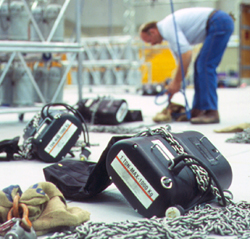
Plenty Of Options
Cases and road trunks make up the bulk of what protects audio equipment, with larger sizes offering wheels for ease of movement. They’re made from a variety of materials, including plastic, metal or plywood.
A variety called ATA or Flight Cases use thin (1/4-inch to 1/2-inch) laminate-covered plywood panels joined with extruded aluminum edging and heavy ball corners for added protection. (By the way, ATA is short for the Air Transport Association of America, and more specifically, the organization’s Specification 300, which covers reusable transit and storage containers.)
Many manufacturers offer cases and trunks sized to fit 2-, 3-, and 4-across in standard trucks and trailers. These truck pack dimension cases usually include stacking cups in the lid that allow a similarly sized case to ride securely atop another, with the wheels of the uppermost case prevented from movement in the recessed stacking cups of the case below.
Road trunk is the common term for larger, heavy-duty cases. They can be item-specific, like a feeder cable trunk, or more generic, loaded differently depending on what is needed at the gig. Some are outfitted with removable dividers that allow different compartmentalization options. (Nice trunks are sometimes referred to as “Cadillacs.”)
Cases may have a hinged lid or be of the “pullover” or “slipover” style, where most of the case, except for a small lower tray, is lifted off. This allows for removal, or use of the item while it stays in the lower rolling tray, and is popular for backline amplifiers, snakes on reels, and loudspeakers.
As the name implies, mic boxes are cases designed to secure and transport microphones, direct boxes and accessories. They commonly include foam inserts that provide specific protection and organization advantages. Work boxes offer drawers and storage areas to organize tools and supplies at shows. I keep separate work boxes for audio, lighting, and backline so the specific tools, parts and supplies needed for each area of production are present and easily accessible.
Cases for mixing consoles come in a variety of styles. Smaller mixers might be stored in briefcase-sized foam-lined satchels, while larger consoles often travel in cases with lift-off lids, with the console sitting the case bottom during use. A feature many mixing consoles offer is a doghouse, a compartment at the rear of the case that allows cables and snake fans to be pre-connected to the console and stored in the case when not in use.
Riding The Rails
Racks are specialized cases that house electronic components, held into place on rack rails. The standard rack rail dimension is 19 inches wide, and gear is designated by how many vertical spaces (or rack units) they use in a rack: single space (1RU) is 1.75 inches, 2RU is 3.5 inches, 3RU, is 5.25 inches, and so on. The equipment, shelves or drawers have “ears” that extend on either side of the front panel, and these allow the item to be bolted onto the rails that are normally tapped for a 10-32 thread bolt.
Racks may offer front rails only or an additional set of rear rails to facilitate supporting larger/heavier equipment like amplifiers. Shock mount racks suspend the rack inside an outer shell either by springs or surrounding the inner rack with foam. These offer more protection for fragile electronics.
Another rack variation is a mixer rack, combo rack or slant top rack that can house a rack-mount mixer on top, oriented in a comfortable operating position with space for additional rack equipment below. We use these styles a lot with our smaller mixers because they allow us to roll in and have everything needed all wired up in one unit—just pop off the lids and plug in the loudspeakers.
A more recent trend has manufacturers incorporating table legs into the removable lids of the racks, turning them into tables. In fact, I won’t buy a new mixer rack or workbox without a table option because it provides a handy place to set up computers and other items by the mixer without having to scrounge up at table at the venue.
Not every case and rack has wheels, so additional helpers like hand trucks and mover’s dollys (a.k.a., “skateboards”) are required on many gigs. Hand trucks must be magical as they have a habit of growing legs and walking off when we’re not looking, so we bring a bicycle lock to secure them to a large road case or lock them back in the truck at a gig.
Don’t forget to add cases, racks, hand trucks and dollies to your preventative maintenance schedule so they too stay in good working condition. A nifty trick for hand trucks that use pneumatic tires is to put sealant (a.k.a., “slime”) inside the tires to lessen the chances of air leaks.
Senior contributing editor Craig Leerman is the owner of Tech Works, a production company based in Las Vegas.


